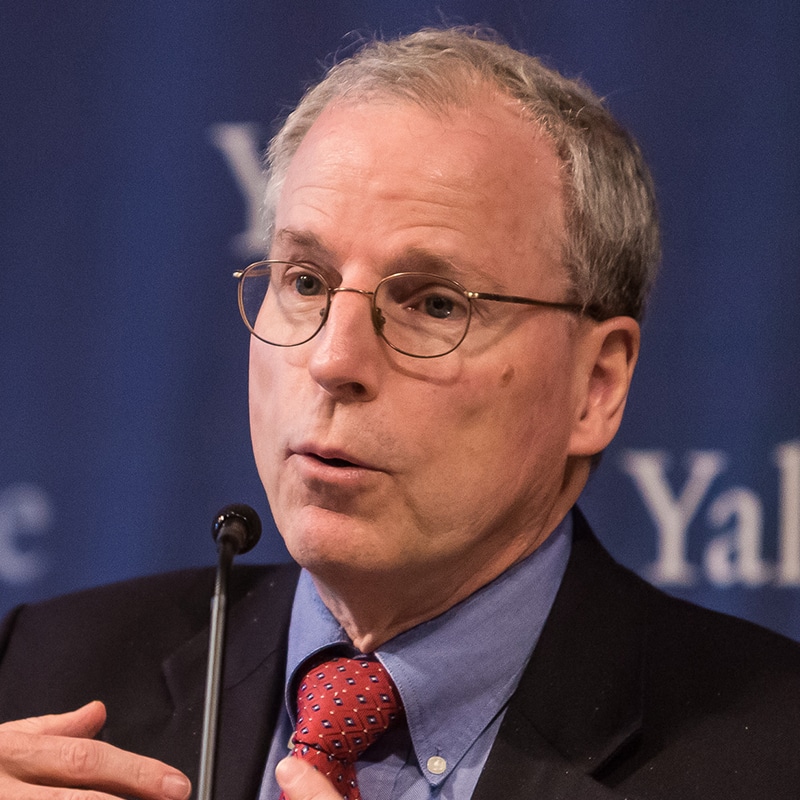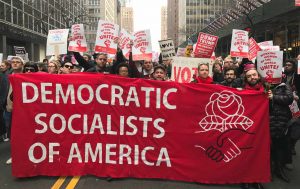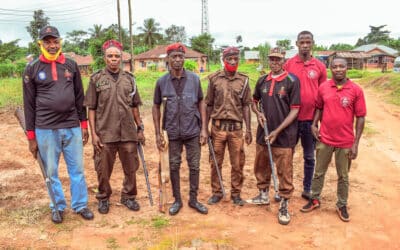In September 2017, U.S. official Brett McGurk expressed concern that Syria’s northwest Idlib province had become “the largest Al Qaeda safe haven since 9/11.” Idlib had fallen to al-Qaeda, in the form of a jihadist coalition led by the group’s Syrian affiliate, the Nusra Front, in March 2015.
Despite acknowledging that Idlib, the last bastion of the supposedly democratic and secular Syrian opposition, was dominated by al-Qaeda, McGurk failed to also note that U.S. planners themselves had played a key role in the terror group’s successful capture of the province. Specifically, he failed to note the key role played by U.S.-supplied TOW anti-tank missiles, which along with Nusra’s suicide bombers, made expelling the Syrian army from Idlib possible.
For example, Syria analyst Hassan Hassan observed in Foreign Policy that in spring 2015 “The Syrian rebels are on a roll” and that “The recent offensives in Idlib have been strikingly swift—thanks in large part to suicide bombers and American anti-tank TOW missiles,” which FSA groups and Nusra deployed in tandem.
Half a dozen?
In contrast to Hassan, U.S. officials have attempted to obscure the importance of U.S.-supplied TOW missiles in the rise of al-Qaeda in Idlib. In a 2021 interview with journalist Aaron Mate, former U.S. Ambassador to Syria Robert Ford claimed that “The United States never gave anti-tank weapons to al-Qaeda.” Mate pushed back against this claim saying, “Not directly, but they gave it to their allies who then gave it to al-Qaeda.” Ford then claimed, “Aaron, the number might be half a dozen,” implying that the number of TOW missiles falling into Nusra’s hands was negligible and played no role in the terror group’s success. Ford then recommended that Mate review the reporting regarding TOW missiles in the conflict by Jakub Janovsky of Bellingcat.
Ford’s comments here are a clearly false. There is considerable evidence that Nusra was able to obtain large numbers of TOW missiles, both by capturing them from U.S.-backed groups, and by co-opting U.S.-backed groups who then deployed the missiles on Nusra’s behalf during the spring 2015 campaign to conquer Idlib.
Further, even before the start of the program to provide TOW missiles, U.S. officials were clearly aware that U.S.-supplied weapons were falling into Nusra’s hands. The New York Times reported in October 2013 that Obama administration officials chose to arm what they referred to as Syrian rebels via a covert program run by the CIA, rather than via a publicly acknowledged program through the Pentagon, not only to avoid the legal issues associated with toppling a sovereign government, but also because, in the words of one former senior administration official, “We needed plausible deniability in case the arms got into the hands of Al Nusra.”
Further, U.S. planners continued shipping the missiles to U.S.-backed groups long after it became clear they had played a key role in Nusra’s conquest of Idlib province. Fearing that not only Idlib, but also Damascus would fall to jihadists fighting with the support of U.S.-backed FSA groups, Russian president Vladimir Putin ordered the Russian air force to intervene on behalf of the Syrian army in September 2015. U.S. planners responded by immediately accelerating shipments of additional TOW missiles.
The New York Times reported on October 12, 2015, just two weeks after the start of the Russian intervention, that FSA groups were now receiving as many TOW missiles as they asked for, and that the U.S. was effectively fighting a proxy war with Russia as a result. One FSA commander explained, “We get what we ask for in a very short time,” while another rebel official in Hama called the supply “carte blanche,” suggesting, “We can get as much as we need and whenever we need them.”
Daveed Gartenstein-Ross of the Foundation for Defense of Democracies (FDD) observed that “at this point it is impossible to argue that U.S. officials involved in the CIA’s program cannot discern that Nusra and other extremists have benefited” from CIA weapons shipments, “And despite this, the CIA decided to drastically increase lethal support to vetted rebel factions following the Russian intervention into Syria in late September [2015].”
In the remainder of this paper, I detail the role of U.S.-supplied TOW missiles in al-Qaeda’s conquest of Idlib.
Khan Sheikhoun
According to the Arab Center for Research and Policy Studies in Qatar, U.S.-made TOW anti-tank missiles were used in the conflict for the first time during the battle for Khan Sheikhoun in April 2014.
According to pro-opposition news site Zaman al-Wasl, the “Hama Gate” campaign to take Khan Sheikhoun was directed from a unified operations room comprised of 13 armed-opposition factions, including most prominently the Nusra Front, the Syrian Revolutionaries Front (SRF), and Ahrar al-Sham.
Before the campaign, U.S. planners had begun supplying these missiles to a newly formed group FSA brigade, Harakat Hazm, or the Steadfastness Movement, made up of 12 small FSA factions and including former Farouq Brigade elements. Videos emerged in early April 2014 of Hazm using the missiles in the town of Hesh, along the M5 highway just north of Khan Sheikhoun.
Speaking to the New York Times, Fares al-Bayyoush, the commander of the FSA’s Fursan al-Haq Brigade, another recipient of TOW missiles and a participant in the battle, explained his group’s reliance on Nusra in the effort to capture Khan Sheikhoun. Al-Bayyoush praised the kind of help that “comes in forms only a jihadi group can provide,” namely suicide bombers, and that “We encourage them actually,’ Mr. Bayyoush said with a laugh. ‘And if they need vehicles, we provide them.”
Nusra’s Prostitutes
Nusra was able to capture TOW missiles from two U.S.-backed groups it had previously cooperated with in Khan Sheikhoun and elsewhere, namely from Harakat Hazm and from the SRF, led by Jamal Maarouf.
In October 2014, Nusra attacked the SRF, taking control of Maarouf’s home base in the Jabal al-Zawiya region in Idlib. After five days of fighting, the SRF surrendered, with roughly half of its fighters defecting to Nusra and the others simply fleeing, while Maarouf himself allegedly fled to Turkey. Nusra was then able to take over the SRF’s weapons caches, with sources close to Nusra claiming the group had captured 10 tanks, 4 BMP’s, 130 cannons, 80 plus TOW missiles, dozens of trucks, and significant quantities of ammo.
Though in this case Nusra forcibly took weapons from the SRF, in the past, Maarouf had simply passed weapons directly to Nusra, at the request of his regional sponsors. Seven months before, in March 2014, the Independent had reported that, “While Maarouf maintains that their military supplies are too few to share, he cites the battle of Yabroud, against the regime, as an example of how his group shared weapons with Jabhat al-Nusra. ‘If the people who support us tell us to send weapons to another group, we send them. They asked us a month ago to send weapons to Yabroud so we sent a lot of weapons there. When they asked us to do this, we do it.’”
After attacking the SRF in October 2014, Nusra also attacked Harakat Hazm bases in Idlib at this time. According to the Washington Post, Hazm was “the biggest recipient of U.S. assistance offered under a small-scale, covert CIA program launched this year, including the first deliveries of U.S.-made TOW antitank missiles” and that the group’s fighters “surrendered their weapons [to Nusra] and fled without a fight.”
All of this suggests that, contrary to Ambassador Ford’s claims, significant numbers of TOW missiles were captured by Nusra at this time.
The conflict between the SRF and Hazm on the one hand, and Nusra on the other, was portrayed in the Western press as one of U.S.-backed moderates fighting against extremists from al-Qaeda. The Washington Post wrote that Nusra’s conflict with the SRF, “appeared to be a concerted push to vanquish the moderate Free Syrian Army.”
However, after reviewing events surrounding the Nusra defeat of the SRF, Jennifer Cafarella of the Institute for the Study of War (ISW) concluded that Nusra’s strategy at the time was not to eliminate U.S.-backed opposition groups in Idlib, but rather to “wield its influence to leverage these groups as force multipliers.”
After defeating Hazm and the SRF, Nusra continued to work closely with other FSA groups. Nusra’s effort to leverage U.S.-backed FSA factions as force multipliers was illustrated just weeks after defeating Hazm and the SRF. In December 2014, Nusra turned its attention to capturing two important Syrian army military bases in Idlib, Wadi al-Deif and Hamidiyeh. According to pro-opposition news outlet Enab Baladi, the FSA’s 13th Division fought on the side of Nusra at both bases, just as it had in Khan Sheikhoun in May 2014.
Al-Jazeera reported that “During its attack on Wadi al-Deif camp, Jabhat al-Nusra used tanks and other heavy weapons that it seized last month from the Syria Revolutionaries Front [SRF], according to Abdul Rahman [of SOHR], including ‘TOW’ missiles.”
Jakub Janovsky of Bellingcat also observed that US-supplied TOW missiles played a key role in Nusra’s capture of the bases. Janovsky writes that, “by the end of 2014 TOWs provided a significant help in a takeover of several government bases – most notably the Wadi Deif base in Idlib.” Recall that Ambassador Ford had cited Janovsky’s work as the bases for his claim that Nusra had only acquired a negligible number (“maybe half a dozen”) TOW missiles.
It is unclear whether the TOW missiles deployed at Wadi al-Deif and Hamidiyeh were formally in the possession of Nusra (captured from the SRF and Hazm) or if they remained in the possession of allied FSA factions such as the 13th Division and were simply deployed on Nusra’s behalf, or both.
The New York Times addressed this issue, reporting that, “reports and images from the operation make two things clear: antitank missiles were used, and Nusra claimed the victory. That means that the American-backed fighters could advance only by working with the Nusra Front, which the United States government lists as a terrorist group, or that they have lost the weapons to the Nusra fighters, effectively joined the group, or been forced to follow its orders. One commander of a group that received antitank missiles said that some F.S.A. fighters were forced to operate them in the battle on behalf of the Nusra Front, which had captured them from American-backed groups. . . [The commander] bitterly likened the F.S.A. to prostitutes, speaking on the condition of anonymity to avoid alienating American officials.”
The New York Times further cited Jamal Maarouf, who explained what was rarely acknowledged, namely that “’No F.S.A. faction in the north can operate without Nusra’s approval,’ Mr. Maarouf said, adding that the front had either bought or terrorized F.S.A. fighters into compliance. ‘Nusra cannot cover every area so they still need them. But once they take control, they will confiscate all weapons or oblige those factions to pledge allegiance.’”
This explains why Nusra never attempted to “vanquish the moderate Free Syrian Army,” as claimed by the Washington Post, and why Nusra continued to work with FSA factions after the group’s attack on the SRF and the Hazm Movement. Because FSA factions were typically subordinate to Nusra, they provided a weapons conduit from Western and Gulf intelligence agencies from which Nusra could benefit.
Working with FSA groups directly, rather than simply capturing TOW missiles from them, was also important because the missiles must be guided by an operator after launch to ensure the target is hit, which can be several kilometers away. Significant skill is required to operate them, and FSA fighters were sent to allied-Gulf states for the specific training needed. Janovsky observed that during 2014, 468 instances of TOW missile launches had been confirmed and that several TOW operators, such as Abu Hamza from the FSA’s 1st Coastal Division, became famous for their targeting abilities.
These weapons would have been of little use to Nusra without the FSA’s highly trained TOW crews to operate them. The question is therefore not how many TOW missiles fell into Nusra’s hands, but how many of the 468 TOW missile launches documented by Janovsky benefitted Nusra, and whether U.S. planners continued to provide TOW missiles to FSA groups once this benefit was known.
Where Credit is Due
At the same time, FSA factions benefitted from this relationship as well, as they were able to claim success in operations that would not have been possible without help from Nusra. The FSA leader in Idlib, Afif Suleiman, publicly took credit for the capture of Khan Sheikoun in May 2014, even though Nusra and Ahrar al-Sham were the major factions leading the campaign, and after Nusra suicide bombers proved crucial in its success. Similarly, FSA chief Salim Idris had taken credit for the opposition assault on the Taftanaz airbase in January 2013, even though Nusra and Ahrar al-Sham were the major opposition factions leading the battle. In April 2013, Omar Abo Laila, spokesman for the FSA General Staff Eastern Area, claimed credit for the capture of the majority of Syria’s oil fields, even though these were in fact captured by, and under the control of, Nusra.
This also explains why the FSA head in Aleppo, Abd al-Qader al-Akaidi, was willing to be filmed alongside ISIS commander Abu Jandal celebrating the capture of the Menagh airbase in August 2013, despite the public relations nightmare this caused for his American patrons, in particular Ambassador Ford.
Akaidi’s FSA fighters (from Liwa al-Tawhid) were only successful in capturing the airbase (after an eight-month siege) once ISIS joined the battle. Suicide bombers again proved crucial. Akaidi had to publicly appear with the ISIS commander, otherwise the FSA would receive no credit for the fall of the airbase and lose credibility on the ground.
Similarly, as the New York Times reported, FSA head Salim Idris himself appeared in a video complaining that the FSA was receiving no credit for participating in the massacre of Alawite villagers in Latakia in August 2013. Idris was “responding to criticism from Islamist groups that his fighters were hanging back.” The massacre, which resulted in 190 dead, including many women and children, with 200 taken hostage, was led by ISIS, Nusra, and Ahrar al-Sham, as detailed by Human Rights Watch.
An opposition activist in the southern Syrian city of Daraa summarized this phenomenon, explaining to the National in January 2014 that, “The FSA and al-Nusra join together for operations but they have an agreement to let the FSA lead for public reasons, because they don’t want to frighten Jordan or the West…Operations that were really carried out by al-Nusra are publicly presented by the FSA as their own.”
U.S. planners were of course aware of this dynamic, and feigned concern in public about U.S.-supplied weapons falling into the hands of al-Qaeda. This was simply for public relations reasons and to maintain plausible deniability of the CIA’s role. U.S. planners did not cut off support to FSA groups deploying TOW missiles on behalf of Nusra after the defeat of the SRF and Hazm, and this further prepared the way for Nusra’s next major victory.
The Army of Conquest
The fall of the Wadi al-Deif and Hamidiya bases opened the way for the next step in Nusra’s efforts to establish an al-Qaeda safe haven in Idlib, namely the assault on the government-controlled provincial capital, Idlib city, in March 2015.
Just before the assault on Idlib, a new jihadist coalition was created, known as the Army of Conquest, or Jaish al-Fatah, with Nusra at its head. David Ignatius of the Washington Post noted that Jaish al-Fatah was not formed on the basis of a decision taken by the participating jihadist factions themselves, but rather at the direction of the foreign intelligence agencies of Turkey, Saudi Arabia, and Qatar, and that, “By pumping weapons to Syrian rebels across the Turkish border, the three countries have forged a new opposition coalition known as the Army of Conquest.”
Kim Sengupta of the Independent reported further that, “Turkish officials admit giving logistical and intelligence support to the command headquarters. Although they deny giving direct help to al-Nusra, they acknowledge that the group would be beneficiaries. . . . . Material support – arms and money – have been coming from the Saudis, say rebels and officials, with the Turks facilitating its passage.”
Ambassador Ford’s claims about TOW missiles during his interview with Aaron Mate should be viewed in this context. Ford’s denial that large numbers of TOW missiles fell into Nusra’s hands is likely not correct (Nusra may have captured 80 TOW missiles from the SRF alone, as mentioned above). But even if his denial is correct, U.S. planners nevertheless knew that Nusra would be the beneficiary of TOW missile shipments to FSA groups allied and subordinate to Nusra, just as Turkish officials had acknowledged this of their own support to the Jaish al-Fatah coalition. Further, TOW missile shipments to FSA groups continued long after their collaboration with Nusra became clear. This clearly shows intent on the part of US planners.
The creation of Jaish al-Fatah was itself part of a Qatari effort to re-brand Nusra, making it easier for America’s regional allies to provide weapons and financing to the group, despite its designation as a terrorist organization. Writing in Foreign Affairs, Aymann al-Tamimi and Daveed Gartenstein-Ross acknowledged tacit U.S. support for arming al-Qaeda’s Syrian affiliate, writing that Nusra “now openly receives financial and other material support from major U.S. allies,” and that U.S. planners “have not gone out of their way to end the support.” Of course, Nusra had long been receiving support from major U.S. allies, but not openly, as was acknowledged by Qatari prime minister Hamad bin Jassim bin Jaber al-Thani in 2017.
Idlib Falls
On March 24, 2015, some 6,000 Jaish al-Fatah fighters began the assault on Idlib city by dispatching suicide bombers against Syrian army checkpoints. U.S.-supplied TOW missiles in turn complemented Nusra’s suicide bombers. Thomas Joscelyn of the Foundation for the Defense of Democracies (FDD) reported that, “Al Nusrah released a video featuring a TOW missile attack in the early hours of the jihadists’ newly-launched offensive against Syrian regime forces in the city of Idlib. . . . It is unclear how many TOW missiles Al Nusrah has in its possession. But it is clear from the videos and pictures published on social media that the group has a stockpile of the weapons, which were captured from Western-backed rebel groups.”
But it was not simply TOW missiles captured by Nusra being deployed in the battle. U.S.-backed FSA factions once again deployed the missiles on Nusra’s behalf during the assault, as in Khan Sheikhoun, Wadi Deif, and Hamadiyyah previously. Reuters reports that “Fighting alongside [Jaish al-Fatah], although excluded from a joint command center, are groups which reject the jihadists’ anti-Western aims and say they receive covert support from the CIA. Two of these are called Division 13 and Fursan al-Haq.” Reuters reports further that, “Abu Hamoud, a commander from Division 13, said his group coordinated with Nusra Front, which the United States considers a terrorist organization, but this does not mean it is aligned to it.” It is of course unclear what meaningful distinction can be drawn between cooperating with al-Qaeda to help it conquer territory, and “aligning” with the terror group.
Major Fares al-Bayyoush, commander of the FSA’s Fursan al-Haq brigade, who had previously expressed appreciation for the help “only a jihadi group can provide,” later made clear his group’s role in helping Nusra conquer Idlib. In an October 2015 interview with the Los Angeles Times, Bayyoush explained that “his group’s TOW missiles played an important role in repelling government tanks during a March offensive in Idlib province spearheaded by an Islamist coalition called the Army of Conquest, which includes Al Nusra Front.” Earlier in the week, a U.S. State Department spokesperson justified U.S.-backed FSA groups’ coordination with Nusra, telling the Los Angeles Times as well that, “We are aware that some moderate opposition groups have coordinated tactically with Nusra out of necessity when fighting against the regime and ISIL,” while adding a meaningless disclaimer that, “However, I would emphasize that the United States supports vetted armed opposition groups and takes extensive measures to minimize the risk of assistance falling into the wrong hands.”
On March 28, 2015, after four days of fighting, Jaish al-Fatah forces captured Idlib city, the second provincial capital (after Raqqa) to fall to jihadist forces during the conflict. On April 25, the nearby town of Jisr al-Shagour fell to the Jaish al-Fatah coalition as well, while on May 28, the last government-controlled town in Idlib province, Ariha, also fell to U.S., Gulf, and Turkish-backed jihadist forces.
Crucial Rearguard Actions
But did U.S.-supplied TOW missiles play a key role in Nusra’s success in these crucial battles, or was their use by the FSA on behalf of Nusra largely immaterial, as suggested by Ford? Janovsky of Bellingcat notes the important role of TOW missiles in the campaign to conquer Idlib generally. He writes that “In early 2015, rebels formed an alliance of a large number of various ideological groups (from moderate FSA units to Jabhat al Nusra) called Jaysh al Fatah. This allowed the rebels to combine resources and various specializations which allowed the rebels to start a large offensive in the Idlib governate using combined arms operations. TOWs and other ATGMs eliminated a significant number of tanks that the government forces had in exposed defensive positions and defeated the pro-Assad usual tank-heavy counterattacks, allowing rebel infantry and artillery to attack and hold weakened positions. At the start of the rebel offensive, the government forces held onto a fairly long, exposed salient which allowed Jaysh al Fatah to effectively turn any pro-government movement inside the salient into a loss of material and manpower.”
Gulf-funded Syria analyst Charles Lister also emphasized the crucial FSA and TOW role, writing that since the summer of 2014, “Idlib in particular represents Jabhat al-Nusra’s most valuable powerbase” and that “none of the major victories in Idlib since early-April [2015] would have been possible without the crucial rearguard actions of U.S. — and Western-backed FSA units and their externally-supplied artillery shells, mortars and American-manufactured BGM-71 TOW anti-tank missile systems.” Lister noted not only the importance of the U.S.-backed FSA groups in assisting Nusra, but that U.S. planners had given orders to cooperate with the jihadists: “The depth of coordination between Western-backed FSA factions, Islamists, Jabhat al-Nusra and other jihadists has increased markedly in Idlib since April, both due to a natural need for cooperation on the ground, but also thanks to a tacit order to do so from the U.S.- and Saudi-led coordination room in southern Turkey.” Lister then offered a bizarre justification for the order for FSA groups to cooperate with Nusra, claiming that “Having spoken extensively with leading commanders from across the Syrian spectrum in recent weeks, it is clear this cooperation has at least partly been motivated by a desire to ensure victories in Idlib do not become strategic gains for al Qaeda [emphasis mine].”
As Brett McGurk’s later comments indicate, U.S. cooperation with Nusra, in the form of sending TOW missiles to FSA groups fighting as force multipliers for the group, did make sure that Nusra’s victories in Idlib became strategic gains for al-Qaeda, in the form of “the largest Al Qaeda safe haven since 9/11.”
‘Not My Islam’
Predictably, U.S. efforts to help al-Qaeda conquer Idlib had grim consequences for many of its residents, large numbers of whom fled after jihadists took control of the city and province. The Guardian reported that while under Syrian government control, Idlib city, with a population of some 165,000 before the war, “had been swollen by hundreds of thousands of displaced people, who had fled there to escape fighting elsewhere.” In contrast, when the jihadists came, many civilians fled. The New York Times reported that although “some Idlib residents celebrated Saturday, cheering as fighters ripped down posters of Mr. Assad or embracing insurgent relatives who returned to the city for the first time in years, others streamed out of the city, with convoys of loaded cars and trucks blocking roads.” Citing the United Nations, the NYT reported that already by April 1, just two days after the jihadist conquest of the city, at least 30,000 residents had fled.
Charles Lister observed that “Specifically in Idlib, Jabhat al-Nusra also began unilaterally imposing a harsher level of Sharia justice, including stoning men and women to death, restricting women’s dress and freedom of public movement, and enforcing the closure of shops during prayer time.”
A Muslim from Idlib who fled the city explained that “The rebels that attacked Idlib at the end of March 2015 came from all sorts of countries. I even saw children carrying weapons. The rebels had a list of names of people who were to be killed, in the majority of cases because they held pro government views. One of my friends, a teacher, was on the list and was shot. . . . I left Idlib with my cousin who had a car. Afterwards, my house was occupied and looted by the rebels. I had planned to sell my house to enable my daughter to study medicine. Now it’s too late. I also worry about our old Christian neighbors. I am a Muslim but the religion of these rebels is not my Islam. I detest Salafism, and do not want to live under it.”
According to one Christian resident of Idib who also fled, “There were about 1300 Christians in Idlib, but now only two remain: an old woman and an old man. We had a good life before the war started. Though we were a small minority, we were, on the whole, well respected.”
The New York Times reports that after the Jaish al-Fatah conquest of Idlib, the jihadists killed two local Christians for selling alcohol, kidnapped the local priest, Father Ibrahim, for 19 days, closed the church, pillaged the church library, and banned public displays of Christian devotion. According to 90-year-old Michel Butros al-Jisri, one of the handful of Christians still in Idlib, word of the priest’s abduction spread quickly and the Christian community quickly “put their families in cars and drove away.” The jihadists then took over their homes and shops.
The Druze community was also targeted, with the BBC reporting that “Druze living in Idlib have been subjected to religious persecution by al-Nusra with several hundred forced to convert to Sunni Islam. The group was also accused of desecrating graves and damaging shrines.” On June 10, Nusra militants massacred 20 Druze in the village of Qalb Lawzah after they protested a Tunisian Nusra commander confiscating the home of a local man accused of being loyal to the Syrian government.
Two days after the Druze massacre, the Washington Post reported that American lawmakers sought to reduce the CIA budget for weapons shipments to FSA groups by twenty percent. By that time, the cost of the CIA program, known as Timber Sycamore, had reached some $1 billion per year. In a sign that CIA planners were satisfied with what Nusra had accomplished with the TOW missiles they had supplied, the Washington Post reported further that, “The measure has provoked concern among CIA and White House officials, who warned that pulling money out of the CIA effort could weaken U.S.-backed insurgents just as they have begun to emerge as effective fighters.”
Conclusion
Because U.S. planners continued to supply TOW missiles to FSA groups long after Nusra was clearly benefiting from them, including after the Russian intervention in September 2015, US support for al-Qaeda in Syria constituted informal U.S. policy. Affinity for al-Qaeda persisted in subsequent years. In 2021, James Jeffrey, the U.S. special representative for Syria engagement told Martin Smith of PBS that the latest iteration of Nusra, Hayat Tahrir al-Sham, was “an asset” to America’s strategy in Syria.
Though the U.S. effort to use jihadist groups to topple the Syrian government has failed, the country remains dismembered and suffering under the weight of crushing sanctions meant to further destroy its economy. Turkish forces collaborating with Nusra (HTS) continue to occupy Idlib, while U.S. forces collaborating with the predominantly Kurdish Syrian Democratic Forces (SDF) continue to occupy northeast Syria. This is where most of Syria’s wheat and energy resources are found. Blocking Syrian government access to these resources allows U.S. planners to further strangle Syria’s economy and immiserate its population. TOW missiles played a key role in dismembering the country and represent an important and shameful chapter in Washington’s now decade-long covert dirty war on Syria.
















